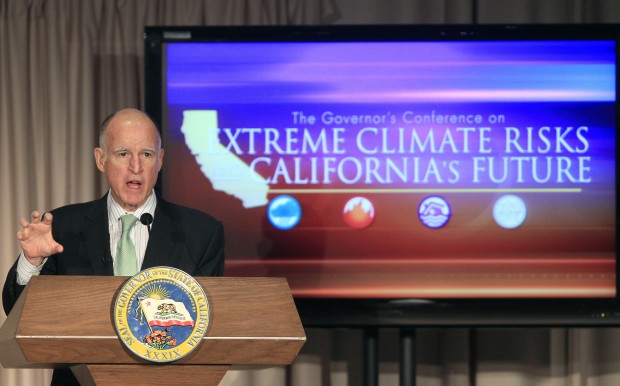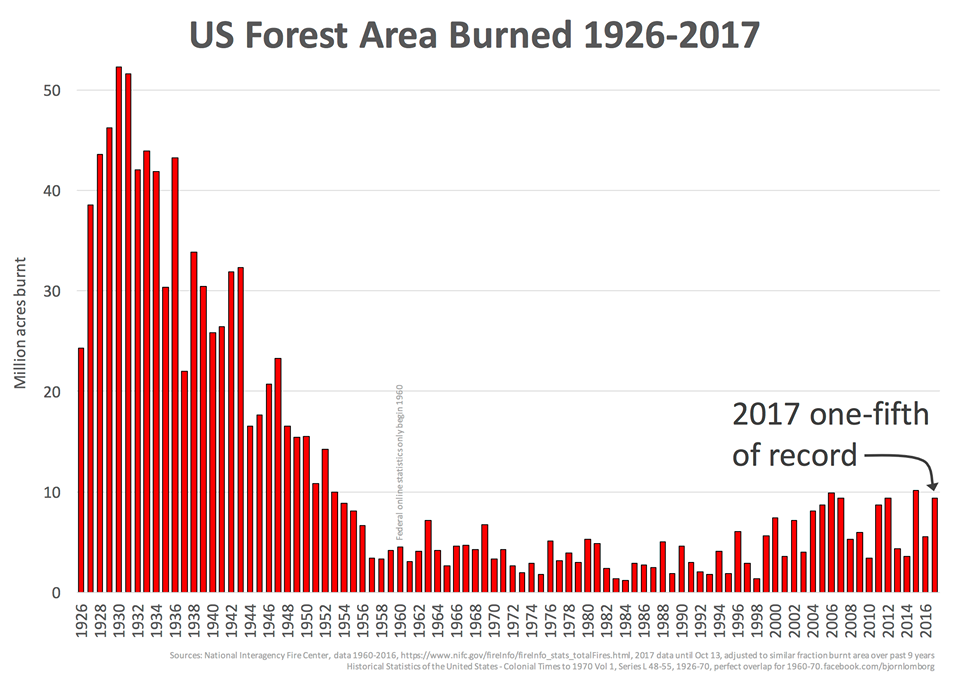Climate Depot Analysis
Once again, the media and climate activists are blaming wildfires on man-made “global warming.” See: California governor blames devastating wildfires on climate change and says deadly winter infernos will be ‘the new normal’

Gov. Brown is even mixing religion into his odd scientific brew: See: From The Hill story: California Gov. Jerry Brown (D) says President Trump’s stance on climate change demonstrates that he does not appear to fear the “wrath of God” or have any regard for the “existential consequences” of his environmental policies. Brown: “I don’t think President Trump has a fear of the Lord, the fear of the wrath of God, which leads one to more humility … this is such a reckless disregard for the truth and for the existential consequences that can be unleashed,” Brown said in an interview on CBS’s “60 Minutes.” (Note: Brown was echoing the film Ghostbusters: Dr Ray Stantz: “What he means is Old Testament, Mr. Mayor, real wrath of God type stuff.” See: ‘The dead rising from the grave!’ Global warming claims imitate scene from 1984 comedy ‘Ghostbusters’ – ‘A disaster of biblical proportions…real wrath of God type stuff’)
Wildfire Reality Check:
But the scientific facts and historical record reveal such “wrath of God” claims to be baseless. The notion that alleged man-made climate change is causing California’s fires is not supported by recent peer-reviewed scientific studies or historical data. Even the LA Times has previously rebuked Gov. Jerry Brown for making such scientifically baseless claims about wildfires. But the hard scientific data revealing no connection to ‘global warming’ will not prevent the media and climate activists from their usual claims trying to link wildfires to ‘climate change.'”
2016 study: Less fires globally than centuries ago
A 2016 study in published by the UK Royal Society reported, “There is less fire in the global landscape today than centuries ago” and the “global area burned” has seen a “slight decline over past decades.” The study, by Stefan Doerr and Cristina Santin of Swansea University in Wales, noted “many consider wildfire as an accelerating problem, with widely held perceptions both in the media and scientific papers of increasing fire occurrence, severity and resulting losses. However, important exceptions aside, the quantitative evidence available does not support these perceived overall trends.” The study also found that the data for the western U.S. indicates “little change overall, and also that area burned at high severity has overall declined compared to pre-European settlement. Direct fatalities from fire and economic losses also show no clear trends over the past three decades.” The researchers concluded: “The data available to date do not support a general increase in area burned or in fire severity for many regions of the world. Indeed there is increasing evidence that there is overall less fire in the landscape today than there has been centuries ago, although the magnitude of this reduction still needs to be examined in more detail.”
In a May congressional hearing, Rep. Tom McClintock, R-Calif., said, “Forty-five years ago, we began imposing laws that have made the management of our forests all but impossible.”He went on to say that federal authorities have done a poor job of implementing methods to reduce the number of deadly fires, and that this has been devastating for America’s wildlands.
“Time and again, we see vivid boundaries between the young, healthy, growing forests managed by state, local, and private landholders, and the choked, dying, or burned federal forests,” McClintock said. “The laws of the past 45 years have not only failed to protect the forest environment—they have done immeasurable harm to our forests.”
In a recent House address, McClintock pinned the blame of poor forest management on bad 1970s laws, like the National Environmental Policy Act and the Endangered Species Act. He said these laws “have resulted in endlessly time-consuming and cost-prohibitive restrictions and requirements that have made the scientific management of our forests virtually impossible.”
Cliff Mass, a climate scientist at the University of Washington explained on his blog Sunday:
Let me demonstrate this to you, with facts, peer-reviewed papers, and the best science can tell us.
First, some facts everyone should agree on:
1. That wildfires took advantage of an environment with sufficient dry fuels (e.g., grasses and shrubs) to support fires.
2. The initiation of the wildfires were associated with the onset of strong offshore (northeasterly) winds that developed as high pressure built into the intermountain West.The question, of course is whether these elements had anything to do with global warming. As we will see, the answer is clearly no. And we will also see that there is a slew of other elements (prior fire suppression, irresponsible expansion of homes, influx of invasive grasses) that have made the situation much worse.
Professor Mass explains that the reason the California Coast becomes dry is that the jet stream goes farther north during the warm season and because the Pacific is relatively cool the region doesn’t get many thunderstorms.
So grasses, shrubs, and other fuels will be dry by the end of summer and during fall, no matter what. And even if the fuels weren’t dry, they would dry within hours of the initiation of strong, offshore winds–which accompany virtually every major fire event.
“Historical analysis of wildfires around the world shows that since 1950 their numbers have decreased globally by 15%,” wrote Dr. Bjorn Lomborg of the Copenhagen Consensus Center and the Copenhagen Business School in the Wall Street Journal on January 23, 2013. Lomborg also pointed to a study published in Nature in November showing globally that “there has been little change in drought over the past 60 years.”
Taking a look at the trends through 2016 via the federal government’s National Interagency Coordination Center, there hasn’t been a spike in US wildfires, in fact, the five year average of 62,248 fires/year (the next to last bar on the right) is lower than the ten year average of 73,304 fires/year. An indication that the number of wildfires has been decreasing (sorry Governor Moonbeam).

In his blog post, Professor Mass gets to the real reason for wildfires in California, political malfeasance:
Those that are claiming the global warming is having an impact are doing so either out of ignorance or their wish to use coastal wildfires for their own purposes. For politicians, claiming that the big wildfires are the result of global warming provides a convenient excuse not to address the real problems:
- Irresponsible development of homes and buildings in natural areas that had a long history of wildfires.
- Many decades of fire suppression that have left some areas vulnerable to catastrophic fires.
- Lack of planning or maintenance of electrical infrastructure, making ignition of fires more probable when strong winds blow.
- Lack of attention to emergency management, or to providing sufficient fire fighting resources
- Poor building codes, improper building materials (wood shake roofs), and lack of protective space around homes/buildings.
And to be extremely cynical, some politicians on the left find the fires as a convenient partisan tool.




